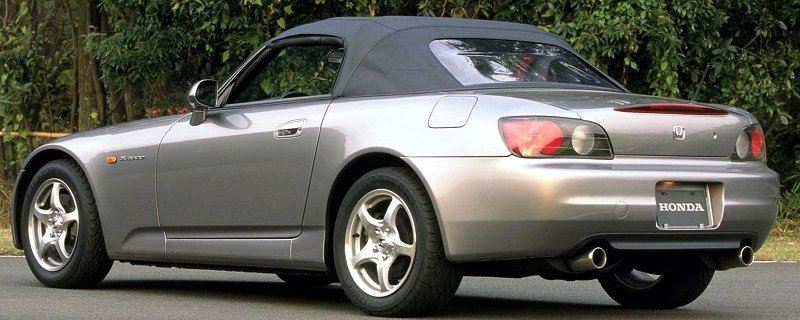
|
|
   





|
|
Powertrain The S2000 powertrain uses a front-engine/ rear-wheel-drive layout. The longitudinally mounted engine is mated to a 6-speed, close-ratio manual transmission. A propeller shaft carries the output of the transmission to a frame-mounted limited-slip differential. The differential drives the rear wheels via separate axle shafts. The 2.0-liter, aluminum-alloy, inline 4-cylinder S2000 engine produces 240 bhp @ 8300 rpm and 207.4 of torque @ 7500 rpm. The cylinder head is also made of aluminum alloy and features dual overhead camshafts, 4 valves per cylinder and VTEC (Honda's variable valve-timing system) on both the intake and exhaust valves. Fuel induction is via Honda's sequential, Multi-Point Programmed Fuel Injection (PGM-FI) and the ignition system is a high-voltage, computer-controlled direct type with individual spark coils for each cylinder. The S2000 engine is 9 percent smaller and 10 percent lighter than a 2.2-liter Prelude engine, and almost as small as a 1.6-liter Civic engine. Yet this compact, lightweight engine has the highest specific power output (120 bhp per liter) of any normally aspirated 2.0-liter production engine in the world. VTEC works by varying valve timing and lift to compensate for the time delay and out-of-phase arrival of the air-fuel charge at the intake valve. Ideally, the valves should remain open for a short duration at low engine speeds and for a longer duration at high engine speeds -- and that is precisely how VTEC works. Honda engineers designed an entirely new close-ratio, 6-speed manual transmission for the S2000. A limited-slip differential was chosen to ensure continuous application of power to the rear wheels, especially when cornering. The transmission and entire drivetrain are designed to be highly rigid and as compact and lightweight as possible, making the vehicle more responsive to driver input and increasing the driver's enjoyment and feel for the car. Chassis A front-engine/rear-wheel-drive configuration was chosen for the S2000. This "classic" layout is widely regarded for its excellent handling characteristics and direct, linear response to control inputs from steering, brakes and throttle -- especially when approaching the chassis and tires' adhesion limit. Since optimum weight distribution and balance are such important factors in achieving excellent handling characteristics, Honda engineers set the S2000's engine and drivetrain as low and close to the center of the chassis as possible. Suspension geometry -- toe, caster, camber, roll centers, etc. -- also have a tremendous effect on handling and response, so Honda engineers designed an all-new double wishbone suspension for the S2000 with optimum geometry. Steering is by an all-new electrically assisted, power rack-and-pinion system, similar to the system used on the NSX. The braking system uses 4-wheel discs and ABS. The system has been specially engineered for optimum efficiency, feedback and control. Interior As with the S2000's exterior, the central design theme of the roadster's interior is performance. Honda engineers designed the interior to contribute to what they call an "interfusion" between the driver and the car. The conceptual model for the S2000 interior is a modern Formula 1 car's cockpit. Outward visibility, simplicity of controls, control feel, comfort -- both machines have these needs in common. Before production, the interior design was extensively tested, including wind-tunnel testing and over 20,000 miles of real-world driving in what Honda calls the maturing phase of the design. It is during this phase of development that details such as control placement, seating and driver visibility are finalized. Base price: $30 000 USD. Story by Honda. |
|
General |
Engine |
Performance |
|
Year : 2000 Make and Model : Honda S2000 Curb Weight : 1250 kg Layout : Front Engine/RWD Transmission : 6-Speed Manual |
Configuration : Inline-4 Displacement : 1997 cc Power : 250 bhp (186.4 kw) @ 8300 rpm Torque : 207.4 nm @ 7500 rpm Redline : 9000 rpm |
Top speed : 241.4 kmh (150 mph) Acc. 0-100 kmh : 5.5 s Acc. 0-160 kmh : 14 s Acceleration 0-¼ mile : 14.8 s Lateral Acc. : --g |
|
|
Site created by Alin Sãndulache |
|